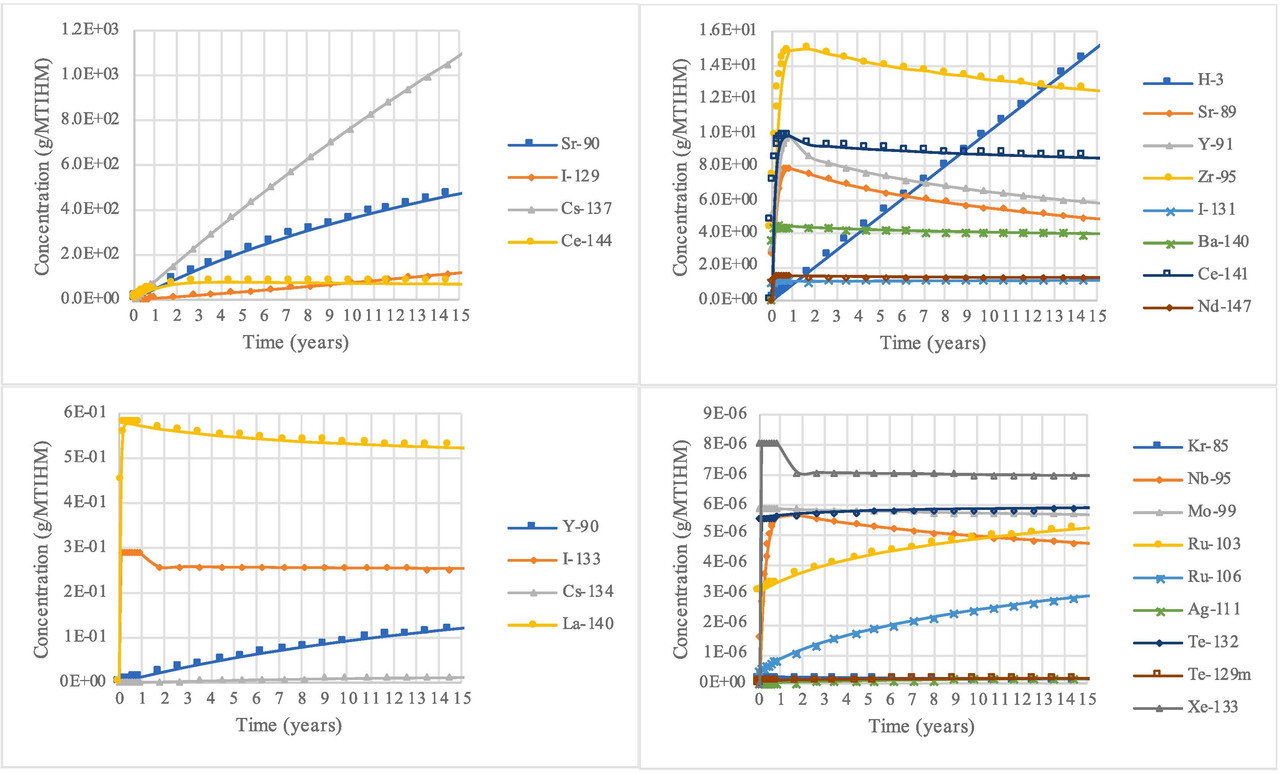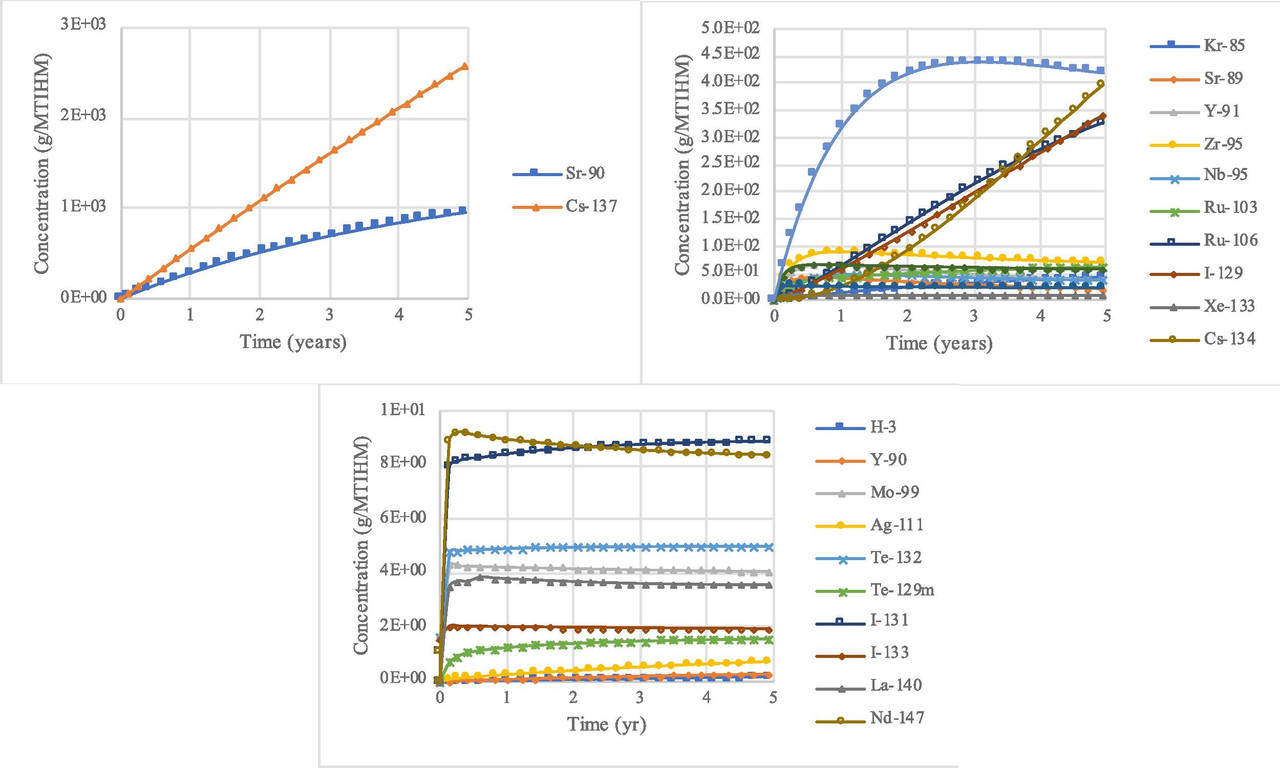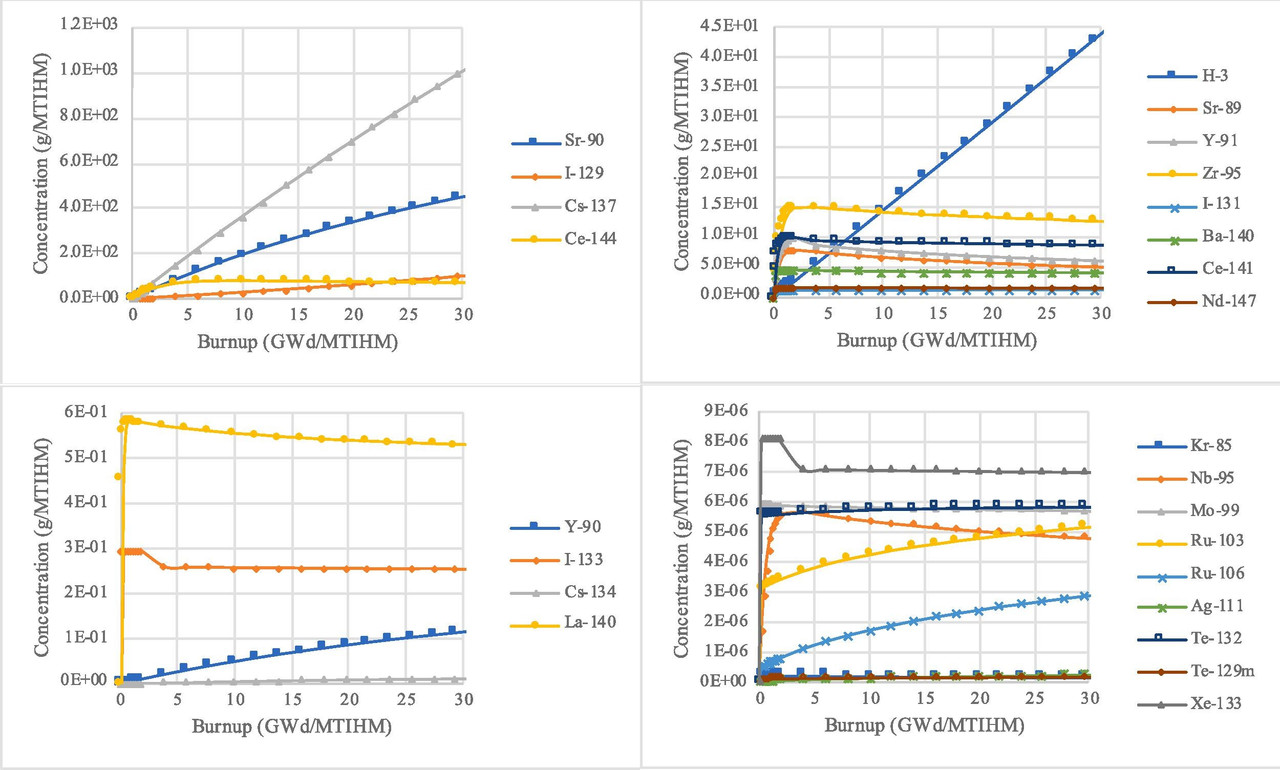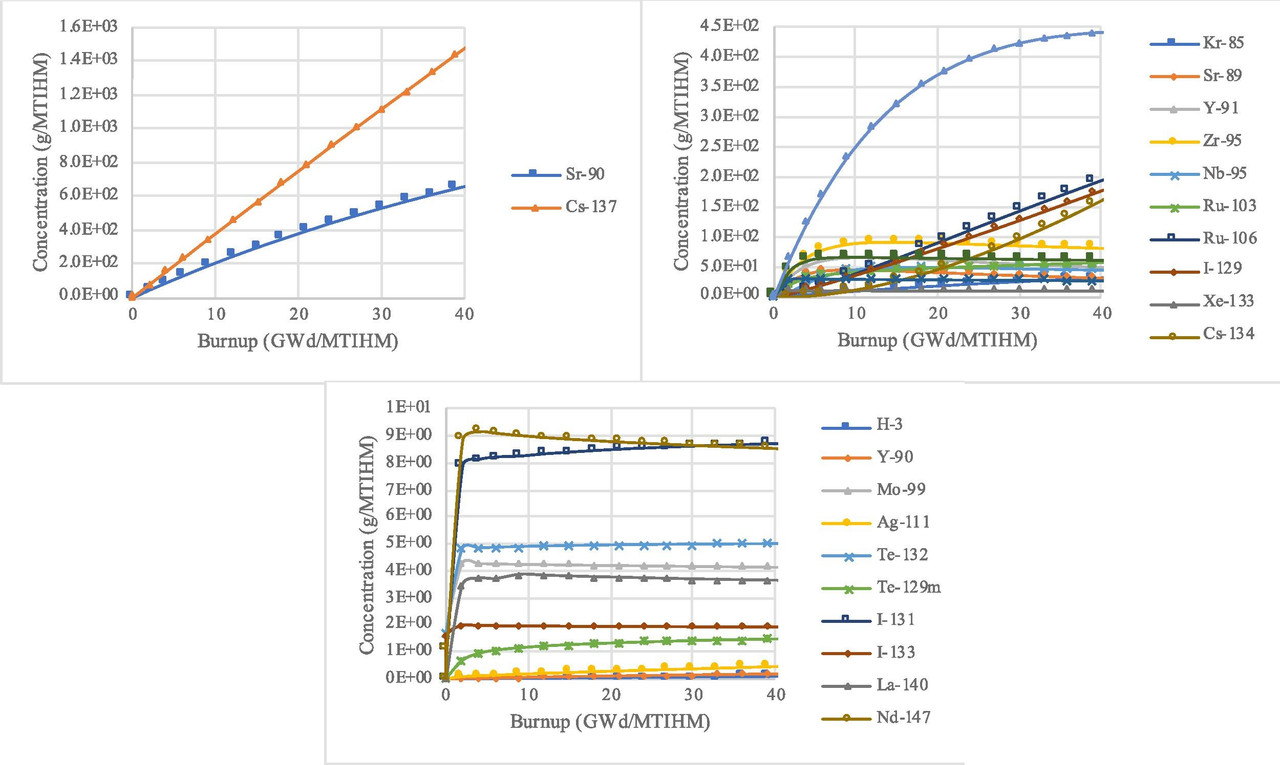Environment & Energy
Related: About this forumGraphic Representations of Bateman Equilibria for Molten Salt Nuclear Reactor Fission Products and Their Volume.
The paper I'll discuss in this post is this one: Sarah Elizabeth Creasman, T. Jay Harrison, Lawrence H. Heilbronn, Fuel depletion study of the molten salt demonstration reactor, Nuclear Engineering and Design, Volume 418, 2024, 112881.
The Bateman Equation is a differential equation that generally can represent how any system that exhibits a rate of decay while also undergoing a rate of formation. I recently referred in this space to this equation as a possible explanation for the failure for the trivial and generally useless wind industry to grow past 8 Exajoules of produced energy from 2022 to 2023:
Should the Phoenix Arise; the Bateman Equation and Wind Energy.
I have shown, using Danish data, that the mean life time of a wind turbine is between 17 and 18 years, within error limits, 17 years and 317 days on average.
The Growth Rate of the Danish Wind Industry As Compared to the New Finnish EPR Nuclear Reactor.
This suggests that the mean half-life of a wind turbine is roughly ln(2)* 17.8 = 12.4 years. Half fail before 12 years, some after very short times as the recent breakup of a turbine at the offshore Vineland industrial wind park; half after 12 years. A few outliers can last for decades, albeit with degraded performance.
This aside, the Bateman equation is most prominently used in nuclear fuel modeling to account for the distribution of the elements therein, both actinides, generally beginning with uranium and ending, for practical purposes with curium, as well as fission products. In this setting, given that many hundreds of different nucleons appear, some very briefly, others long lived, the Bateman equation is actually a coupled series of coupled differential equations. These coupled differential equations, the general form of which is below, is most often solved numerically using computers, an general solution has been reported by a Polish scientist.
In differential form, the equation as used in nuclear fuel evolution is here:

Many computer programs exist to solve the equation(s) and generally they generally correspond fairly well with experiment on an industrial scale as observed when used nuclear fuels are reprocessed, as they should be.
The paper cited at the outset refers to a kind of reactor that has enjoyed some general public enthusiasm, a molten salt reactor, (MSR) pioneered at Oak Ridge National Laboratory in the 1960's using thorium fuels to generate, via neutron capture, an isotope of uranium which was extinct on earth 233U, an element of the 249Cf decay chain, whose longest lived isotope is 237Np. This decay chain has been reestablished on Earth anthropogenically. (It has generated a lot of interest in nuclear medicine applications for cancer treatment because another member of the decay chain is 225Ac.)
For a long time, I was among the enthusiasts for this type of reactor, the MSR, but I've sort of changed my mind for various reasons: It's not a bad reactor, but I personally feel we could do better, not there is anyone who cares what I think. (I like fluid metal fuels, although the paper points to a problem with fluid fuels I'd never really considered, a manageable problem, but one requiring consideration.)
What is interesting about the paper is that the analysis therein shows both the small quantities of fission products generated relative to the actinides therein, and includes graphics showing the asymptotic approach to secular equilibrium which fission products exhibit, that is their approach to a point at which they are decaying nearly as fast as they are formed. This is shown graphically.
Some text from the paper:
MSRs have a lot of flexibility in the fuel cycle and have good fuel utilization. MSRs also have several fuel options—including Th, Pu, and U—that can be operated as a breeder, burner, or self-sustaining reactor to meet current goals and adapt to the current most economically advantageous fuel, making the fuel options very versatile (Moir, 2008). Additionally, by having the option to be operated as a breeder or burner reactor, the impacts on the front end of the fuel cycle and the current inventory of spent nuclear fuel can be reduced. Another potential benefit of MSRs is the possibility for an online processing system that can remove certain fission products and add more fuel to the molten salt without shutting down the reactor.
One of the critical steps in licensing a new reactor is fuel qualification, including safety criteria, which is supported by source term considerations (Drzewiecki et al., 2021). As defined by the US Nuclear Regulatory Commission (NRC), a source term is “the types and amounts of radioactive or hazardous material released to the environment following an accident” (US NRC, 2021). In the early 1990s, the NRC introduced the mechanistic source term (MST) as an alternative to licensing using TID-14844 source terms. MST is a new type of source term defined as “the result of an analysis of fission product release based on the amount of cladding damage, fuel damage, and core damage resulting from the specific accident sequence being evaluated...”
As a chemist rather than a nuclear engineer, I am most interested in the separation and recovery of fission products for use; something about which I think for much of my time. The original MSR used a separation strategy (offline) of which I am very, very, very fond, fluoride volatility, which I believe would be appropriate for our inventory of used nuclear fuels. Much of the current world inventory of 233U was derived by this process in the 1960's. The opportunity for online reprocessing, mentioned in the introduction is definitely what appeals to me about fluid fuels.
The paper continues and a little further on reports some implications:
Of interest is the graphic representations of fuel evolution, which among other things, demonstrates the quantities of fission products generated over periods of a decade, the stuff that people who in my opinion are rather ignorant, referring to these materials as "nuclear waste." (I like to think of them as "products," not "waste," as they can be utilized to solve some otherwise intractable environmental problems.)
Some graphics from the paper:

The caption:

The caption:

The caption:

The caption:
In a fluid phase reactor, many of the volatile fission products are removed continuously, in particular the noble gases krypton and xenon, but others as well, others plate out (precipitate owing to insolubility). In this particular MSR design, some of solid elements that plate out are some that are extremely valuable "platinum group" metals, ruthenium, rhodium, platinum. Silver is also said to plate out. (They can also be removed online using electrochemistry.)
Thus some of the fuel chemistry ratios between traditional light water reactors and fluid phased reactors are thus shown in the following figure.

The caption:
The nice thing about these graphics is that they show the approach to secular equilibrium, where the radioisotopes are decaying as fast as they form, particularly for the shorter lived nuclides. That is the point of this post, but one should also note the units in the ordinates of the graphics showing the fission products accumulating in units of grams per metric ton of fuel. This obviously represents quantities of matter much easier to handle than the billions of metric tons of fossil fuel waste we dump each year as a result of fear and ignorance associated with antinuclear rhetoric. I note that in the 70 year history of accumulation of used nuclear fuel in the United States, storage has yet to kill anyone. This is very different that fossil fuel waste, aka air pollution which kills vast numbers of people continuously and is driving the collapse of the planetary atmosphere.
I trust you'll manage to find some enjoyment this weekend, despite the very painful collapse of our Democracy into an orgy of stupidity.